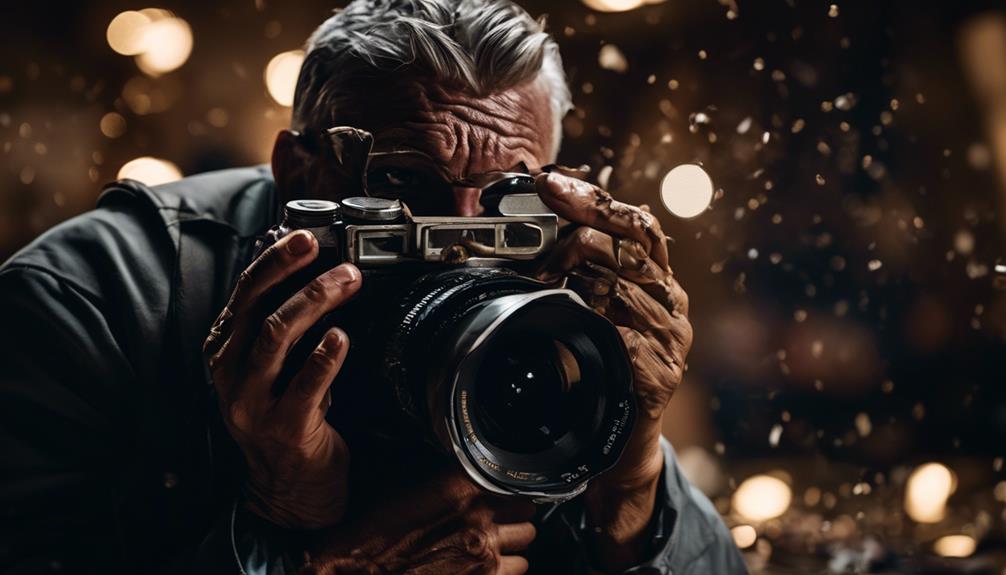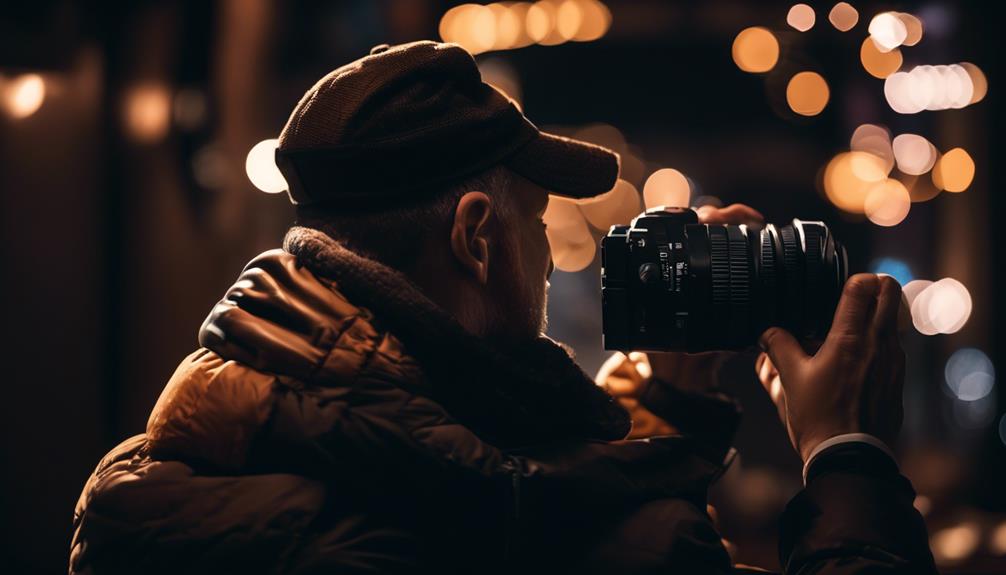Please note this post may contain affiliate links picked by me (Jay) that I have deemed may be of interest or relevant to you the reader of this.
These links do not affect the cost of the thing if you decide to purchase but i may get a little money if you choose to purchase.
For more information on my affiliate link policy click here.
Photography, like a double-edged lens, captures both the beauty and complexity of the world around us. It has the power to freeze a moment in time, immortalizing emotions, stories, and cultures.
Yet, within this seemingly innocent act of capturing inspiration lies a deep undercurrent of ethical dilemmas. The very essence of photography, with its ability to stimulate our senses and ignite our curiosity, often collides with the boundaries of morality, raising questions about ownership, consent, cultural sensitivity, and truth.
In this discussion, we will explore the multifaceted reasons why photography inspiration encounters ethical issues, peering into the intricate web of plagiarism, invasion of privacy, cultural appropriation, manipulation, and exploitation that intertwines with this captivating art form.
So, let us embark on this journey together, as we unravel the complexities and navigate the ethical terrain that lies beneath the surface of a photograph.
Key Takeaways
- Plagiarism and copyright infringement tarnish the integrity of photography.
- Cultural appreciation should be done with sensitivity and respect.
- Subjects should be fairly compensated for their participation in photo shoots.
- Lack of consent can lead to negative consequences such as invasion of privacy and emotional distress.
Plagiarism and Copyright Infringement
Plagiarism and copyright infringement are grave ethical concerns that can tarnish the integrity of photography and hinder the creative process. As a photographer, I understand the importance of respecting the work of others and protecting my own intellectual property.
The concept of fair use is often debated in the photography community, as it allows for limited use of copyrighted material without permission from the original creator. While fair use can be a valuable tool for artists seeking inspiration, it's essential to tread carefully and ensure that our work doesn't cross the line into infringement.
In today's digital age, it has become easier than ever to copy and distribute images without proper attribution or permission. This not only violates the rights of the original creator but also undermines the value of their work. As photographers, we must be vigilant in protecting our own intellectual property and respecting the rights of others.
This involves properly crediting the original source when using images for inspiration and seeking permission when necessary.
Invasion of Privacy and Consent
In my journey as a photographer, I've come to recognize the delicate balance between capturing powerful images and respecting the privacy and consent of those involved. Informed consent is a cornerstone of ethical photography, ensuring that subjects are fully aware of how their images will be used and giving them the opportunity to give or withhold permission. This is especially important in situations where sensitive or personal moments are being captured.
When it comes to candid photography, the line between capturing a genuine moment and invading someone's privacy can often become blurred. Candid photography can result in some of the most authentic and captivating images, but it's essential to approach this style of photography with caution and respect. While it may be tempting to capture a spontaneous moment without the subject's knowledge, it's crucial to consider the potential impact on their privacy and dignity.
Obtaining consent for candid photography can be challenging, as the nature of the genre often revolves around capturing people in their natural state. However, there are ways to navigate this ethical dilemma. One approach is to establish a relationship with the subject before taking their photograph, ensuring they're comfortable with your presence and intentions. Another option is to seek permission after capturing the image, giving the subject the opportunity to review and decide whether they're comfortable with it being used.
Cultural Appropriation in Photography
As a photographer, I'm constantly aware of the potential for cultural appropriation and the responsibility I have to approach this subject with sensitivity and respect.
Cultural appreciation is an important aspect of photography, but it must be done in a way that acknowledges and respects the cultural background being portrayed. Ethical storytelling is essential to ensure that our work doesn't perpetuate harmful stereotypes or exploit marginalized communities.
When it comes to cultural appropriation in photography, there are a few key considerations to keep in mind:
- Research and Education:
- Take the time to educate ourselves about the culture we're exploring through our photography.
- Understand the historical and social context of the culture to avoid misrepresentation.
- Collaboration and Consent:
- Engage with the community being photographed and seek their input and consent.
- Collaborate with local individuals to tell their stories in an authentic and respectful manner.
Manipulation and Misrepresentation
Through the lens of a camera, reality can be manipulated and misrepresented, altering the truth for the sake of an image. In the world of photography, image manipulation has become a common practice, allowing photographers to create visually stunning narratives that captivate audiences. However, this artistic freedom comes with ethical implications, as it blurs the line between truth and fabrication.
| Image Manipulation | Visual Storytelling |
|---|---|
| Allows for the alteration of reality | Enhances the narrative |
| Can be used to enhance aesthetics | Creates emotional impact |
| Offers creative possibilities | Engages the viewer |
Image manipulation can take various forms, from simple adjustments like color correction or cropping, to more complex techniques such as compositing or removing elements from an image. While these practices can enhance the visual appeal of a photograph, they also have the potential to misrepresent reality. When an image is manipulated to the extent that it no longer accurately represents the original scene, it raises questions about the photographer's intent and the authenticity of the image.
On the other hand, image manipulation can also be seen as a powerful tool for visual storytelling. By altering elements within an image, photographers can create a narrative that evokes specific emotions or conveys a particular message. Manipulated images have the ability to engage viewers on a deeper level, drawing them into a world that is both familiar and fantastical.
As photographers, it is crucial to recognize the ethical implications of image manipulation and strive for transparency in our work. While visual storytelling can be a powerful tool, it is important to ensure that the manipulation serves a purpose and does not mislead or deceive the viewer. By using image manipulation responsibly, we can create captivating narratives while maintaining the integrity of the art form.
Exploitation of Subjects and Locations
With the manipulation of images raising questions about authenticity, it's imperative to also examine the potential exploitation of subjects and locations in photography. As a photographer, I'm aware of the power dynamics that can exist between the person behind the lens and the subjects in front of it. This power dynamic can often lead to the exploitation of individuals and the places they inhabit.
Here are some key points to consider:
- Fair compensation:
- It's essential to ensure that subjects are fairly compensated for their participation in a photo shoot. This includes not only financial compensation but also providing proper credit and recognition for their contribution.
- Furthermore, photographers should strive to create opportunities for ongoing collaboration and involvement, allowing subjects to have a voice in how their images are used and shared.
- Power dynamics:
- Photographers hold a certain level of authority and control in the creation and dissemination of images. It's crucial to be mindful of the power dynamics at play and to approach subjects and locations with respect and sensitivity.
- This includes obtaining informed consent, maintaining open lines of communication, and being receptive to feedback and input from the individuals being photographed.
Frequently Asked Questions
How Can I Protect My Photography From Plagiarism and Copyright Infringement?
As a photographer, protecting my work from plagiarism and copyright infringement is crucial.
To safeguard my photography, I make sure to obtain proper licensing for my images and clearly assert my intellectual property rights.
This not only helps me maintain control over my work but also ensures that I receive proper recognition and compensation for my creativity and effort.
What Are the Legal Consequences of Invading Someone's Privacy and Taking Their Photograph Without Consent?
The legal ramifications of invading someone's privacy and taking their photograph without consent can be severe. In some countries, it's considered a violation of privacy rights and can result in hefty fines or even imprisonment.
As a photographer, it's crucial to respect the boundaries and consent of your subjects. By doing so, not only do you avoid legal trouble, but you also maintain ethical integrity in your work.
Respecting privacy rights is essential in creating a responsible and morally sound photography practice.
Can You Provide Examples of Cultural Appropriation in the Field of Photography?
Cultural sensitivity and respecting cultural boundaries are crucial aspects of photography. It's essential to understand that cultural appropriation can occur in the field of photography when photographers borrow or imitate elements from another culture without proper understanding or respect. This can lead to misrepresentation and exploitation.
Examples of cultural appropriation in photography can include using traditional clothing or symbols without permission, perpetuating stereotypes, or exploiting cultural practices for personal gain. It's important for photographers to be aware of these ethical issues and strive for cultural understanding and inclusivity in their work.
How Can Photographers Ensure They Maintain Ethical Standards When Manipulating or Misrepresenting Images?
Maintaining ethical standards in manipulating and misrepresenting images is crucial in photography. The ethical implications of digital manipulation in photography highlight the importance of transparency and honesty.
Consent plays a significant role in photography ethics, ensuring that subjects are aware of how their images will be used. By adhering to these principles, photographers can navigate the complex terrain of inspiration without encountering ethical issues, fostering a more respectful and responsible approach to their craft.
What Steps Can Be Taken to Prevent the Exploitation of Subjects and Locations in Photography?
To prevent the exploitation of subjects and locations in photography, it's crucial to adhere to ethical guidelines and practice responsible photojournalism. By respecting the dignity and rights of individuals and communities, we can ensure that our work doesn't harm or misrepresent them.
This can be achieved through obtaining informed consent, accurately portraying the context, and avoiding sensationalism. It's our responsibility as photographers to prioritize the well-being of our subjects and approach our work with integrity and empathy.
Conclusion
In conclusion, the world of photography inspiration isn't without its ethical dilemmas.
Plagiarism and copyright infringement threaten the integrity of artists' work. Invasion of privacy and lack of consent raise important questions about the boundaries of capturing moments. Cultural appropriation challenges our understanding of representation.
Manipulation and misrepresentation distort reality. The exploitation of subjects and locations perpetuates power imbalances.
As photographers, we must navigate these issues with empathy and integrity, striving to create meaningful and thought-provoking art while respecting the rights and dignity of others.

